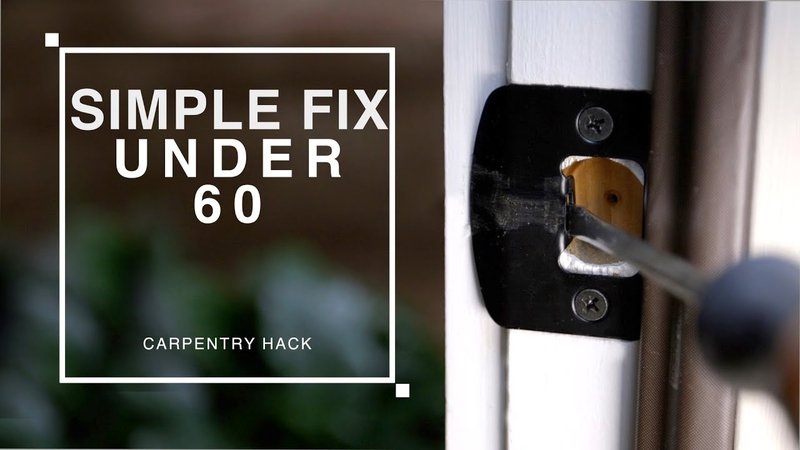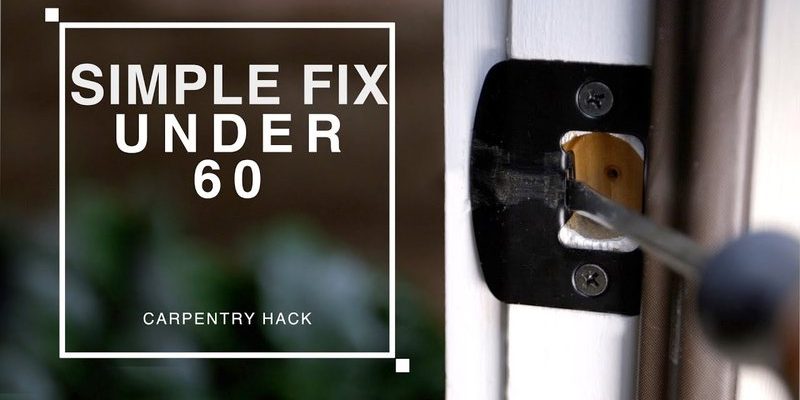
You might have noticed this on a blustery day: the bottom corners of your old wooden door (maybe it’s a classic Therma-Tru or a basic steel pre-hung model from Home Depot) just won’t seal no matter how much you try to close it tighter. Air sneaks in, dust settles on your floors, and sometimes you even see daylight peeking through. Honestly, you’re not alone—this is one of the most common problems homeowners face, no matter the brand. Let’s unpack what causes this and walk through the steps to fix it, even if you’re brand new to DIY door troubleshooting.
Why Exterior Doors Leak Air Around the Bottom Corners
To fix a leaky door, it helps to know why those leaks happen in the first place. Most exterior doors—whether they’re fiberglass, wood, or steel—rely on weatherstripping and a threshold to block outside air. Over time, though, both of these can wear out, get misaligned, or just weren’t installed that well to begin with. Think of your door as a lid on a cooler: if the gasket twists or the lid warps, cold air leaks everywhere.
Here’s the thing: even high-end doors like Andersen or Masonite models can develop leaks if parts get old or loose. Tiny gaps open up as the house settles or when the threshold shifts with temperature changes. Sometimes, the culprit is just a worn sweep or a bit of missing caulk. Other times, it’s about the door’s fit—if it’s sagging on its hinges, even new weatherstripping won’t help much. You might be wondering if slapping on more tape or foam will fix it, but the real trick is to find the leak’s exact cause.
How to Diagnose Air Leaks in the Bottom Corners of Your Door
Before you run to the hardware store, take a minute to really inspect your door. Close it slowly and look closely at the bottom corners—can you see light coming in? Run your hand along the inside edges, especially on a windy day, to see if you can feel air movement. You can also grab a flashlight, stand outside at night, and have someone look for light leaking inside. Pay special attention to:
- The condition of the rubber or vinyl door sweep at the bottom
- Any visible gaps between the door and threshold, especially at the corners
- Missing or crushed weatherstripping along the sides or bottom corners
- Loose or warped thresholds that don’t line up right with the door
If you find dust, dirt, or water stains right at those corners, you’ve likely found the exact spot where outside air is sneaking in. Make a mental note—or better yet, snap a picture—so you know exactly what needs fixing.
Replacing or Adjusting the Door Sweep
A worn-out door sweep is one of the usual suspects when it comes to exterior door air leaks. This is that strip of rubber, vinyl, or bristles attached to the bottom edge of your door. Its whole job is to keep out drafts, insects, and moisture. When it gets cracked, flattened, or ripped, air can shoot right through those bottom corners.
Let me explain how to replace or adjust a sweep:
- Remove the old sweep: Open the door and look underneath. Some sweeps slide off; others are held with screws or staples. Gently pry or unscrew it. If it’s glued, use a putty knife to loosen it.
- Measure and buy a new sweep: Bring the old one to the store to match the size, or measure the door width. Look for universal door sweeps or ones labeled for your door brand.
- Install the new sweep: Slide or screw the new sweep onto the bottom of the door, making sure it touches the threshold all the way across. If it has an adjustable height, set it so it just brushes the threshold but doesn’t drag too hard.
Sometimes just a new sweep will solve the problem. But if you still feel a draft after swapping it out, you probably need to tackle the threshold or the weatherstripping too.
Sealing Gaps with Weatherstripping
Weatherstripping is like the “gasket” for your door—it lines the sides and bottom corners to create a tight seal. If it’s missing, brittle, or squished flat, wind can whistle right in. You might even see the old foam or vinyl peeling off after a few years (I’ve definitely opened the door to a little pile of crumbly gray stuff more than once).
Here’s how to add or replace weatherstripping:
- Choose the right type: There are adhesive-backed foam strips, V-shaped vinyl, or magnetic strips for steel doors. Universal weatherstripping works for most brands, but check the packaging for compatibility.
- Remove the old material: Peel away any old weatherstripping, scraping off sticky bits with a putty knife.
- Clean the surface: Use a damp rag to wipe down the edges where you’ll install the new strip.
- Cut to fit: Measure each door edge—especially the bottom corners—and cut strips to match.
- Stick or nail it on: Press adhesive-backed strips firmly into place, or use small nails for other types. Make sure the corners are sealed, not just the middle.
Pro tip: Shut the door and check the fit. The weatherstripping should compress slightly but let the door latch easily. If it’s too tight or still leaking air, adjust the position or try a thicker strip.
Adjusting the Threshold for a Better Seal
A leaky bottom corner sometimes points straight to the threshold—the metal or wood plate the door sits on. If it’s too low, warped, or loose, air will find its way through the tiniest gaps. Certain thresholds have screws you can turn to raise or lower the entire plate, letting you fine-tune the fit.
Here’s how to check and adjust your threshold:
- Look for adjustment screws: Most newer thresholds (like from Masonite or Feather River) have visible screws along the top. Try turning them a quarter-turn at a time—clockwise to raise, counterclockwise to lower.
- Test the seal: Close the door after each adjustment. The bottom sweep should just touch the threshold and compress the weatherstripping at the corners.
- Tighten any loose screws: Thresholds can loosen over time. Tightening them can pull the threshold snugly into place, reducing air leaks.
If your threshold is old, cracked, or just doesn’t adjust, you might need to replace it. Universal thresholds are sold in standard sizes and are easy to cut to fit. Just make sure to measure carefully before you buy—or bring the old one to the store for comparison.
Fixing Door Alignment and Tightening the Hinges
Every so often, the real problem isn’t the seal or the sweep, but the way the door hangs in the frame. Over time, exterior doors can sag or shift, especially if the hinge screws loosen or the house settles. Even the top-rated brands like Therma-Tru or Jeld-Wen aren’t immune to a little gravity and time.
You might be wondering how to tell if this is your issue. Look for signs like uneven gaps around the door, rubbing when you open or close it, or visible sagging. Here’s what to do:
- Check the hinges: Tighten all screws on the door and frame side using a screwdriver. Sometimes, just a little turn is all it takes.
- Reinforce with longer screws: The screws closest to the bottom corners tend to pull loose first. Swap them for 3-inch wood screws to anchor the hinge deep into the framing.
- Test the fit: After tightening, close the door to see if the gap at the bottom corners has improved. If needed, adjust the hinges by loosening slightly and repositioning before tightening again.
Honestly, this step gets overlooked, but it’s crucial. If the door isn’t square, no amount of weatherstripping will keep drafts out of those corners.
Using Caulk to Seal Permanent Gaps
If you’ve tried all the usual fixes—new sweep, fresh weatherstripping, a tweaked threshold—and there’s still a bit of daylight at the corners, it might be time for a bead of caulk. This is especially helpful for small, fixed gaps between the threshold and the jamb, or where the frame meets the floor.
Let me break down the process:
- Pick the right caulk: Use exterior-grade silicone or paintable latex caulk, designed for doors and windows.
- Clean and dry the area: Dust, dirt, and moisture will keep caulk from sticking. Give everything a quick wipe first.
- Apply a thin bead: Run the caulk along the seam at the bottom corners—don’t overdo it, just enough to seal the visible gap.
- Smooth with your finger: For a clean finish, smooth the caulk with a wet finger or a caulk tool.
- Let it dry: Check the label for drying times, and don’t open or slam the door until it’s fully cured.
Whether you’re working with a brand-new steel door or an old wooden entryway, a little caulk goes a long way for stubborn air leaks.
Comparing DIY Fixes vs. Professional Door Repair
You might be asking yourself, “Should I just call a pro?” Honestly, most exterior door air leaks around the bottom corners are DIY-friendly if you’re patient. Swapping sweeps, sticking on weatherstripping, or tightening hinges takes basic tools and a bit of time—much less than dealing with a total door replacement.
But here’s when it makes sense to bring in a pro:
- The door or frame is badly warped or rotten
- You see water damage, mold, or soft spots around the sill
- The leaks don’t go away after trying all the above fixes
- The door is a custom size or a tricky brand
A professional repair can re-square the frame or swap out the whole threshold—stuff that’s a pain without the right tools. Still, for many folks, a $10 sweep, a pack of weatherstripping, and a tube of caulk do the trick.
Simple Maintenance to Prevent Future Air Leaks
Once you’ve sealed your door’s bottom corners and stopped the drafts, it’s smart to keep up with a little maintenance, so you’re not right back where you started next season. Here’s what helps:
- Check weatherstripping and door sweeps every fall and spring. Replace anything that’s cracked, peeling, or missing.
- Clean the threshold and sweep regularly—dirt buildup can stop the seal from working properly.
- Tighten hinge screws if the door feels loose or starts to sag.
- Inspect caulk lines after heavy rain or snow, and reapply as needed.
A bit of regular attention makes a big difference, especially if you live in a spot with wild temperature swings or lots of wind. Your door will last longer, work better, and keep your home feeling just right all year long.
Wrapping It Up: No More Drafty Door Corners
Fixing an exterior door that leaks air around the bottom corners isn’t rocket science, but it does take a little hands-on looking and a willingness to try simple solutions. Whether your door is from Pella, Jeld-Wen, or a no-name brand, the core steps are the same: inspect for gaps, replace worn-out seals, adjust the threshold, and check the hinges. Sometimes, all it takes is a new sweep or a strip of weatherstripping to make your home feel warmer, tighter, and a whole lot more comfortable.
If you run into something weird (like water damage or a crooked frame), don’t be afraid to call in a pro, but for most people, these fixes are totally doable. Take your time, do it right, and you’ll kick those drafts to the curb—literally. Your toes (and your energy bill) will thank you.
